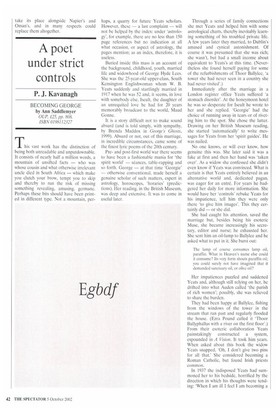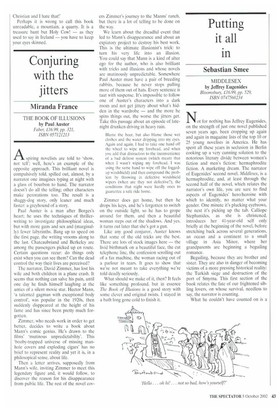A poet under strict controls
P. J. Kavanagh BECOMING GEORGE by Ann Saddlemyer OUP, £25, pp. 808, ISBN 0198112327 This vast work has the distinction of being both unreadable and unputdownable. It consists of nearly half a million words, a mountain of unsifted facts — who was whose cousin and what otherwise irrelevant uncle died in South Africa — which make you clutch your brow, tempt you to skip and thereby to run the risk of missing something revealing, amusing. germane. Perhaps these bits should have been printed in different type. Not a mountain, per haps, a quarry for future Yeats scholars. However, these — a last complaint — will not be helped by the index: under 'astrology', for example, there are no less than 150 page references but no indication at all what occasion, or aspect of astrology, the pages mention; as an index, therefore, it is useless.
Buried inside this mass is an account of the background, childhood, youth, married life and widowhood of George Hyde Lees. She was the 25-year-old upper-class, South Kensington Englishwoman whom W. B. Yeats suddenly and startlingly married in 1917 when he was 52 and, it seems, in love with somebody else. Iseult, the daughter of an unrequited love he had for 20 years memorably broadcast to the world, Maud Gonne.
It is a story difficult not to make sound absurd (and is told simply, with sympathy, by Brenda Maddox in George's Ghosts, 1999). Absurd or not, out of this marriage, in incredible circumstances, came some of the finest lyric poems of the 20th century.
Preand post-first world war there seems to have been a fashionable mania for 'the spirit world' — seances, table-rapping and so forth. George — at that time 'Georgie' — otherwise conventional, made herself a genuine scholar of such matters, expert in astrology, horoscopes, choraries' (predictions). Her reading, in the British Museum, was deep and extensive. It was to come in useful later. Through a series of family connections she met Yeats and helped him with some astrological charts, thereby inevitably learning something of his troubled private life. A few years later they married, to Dublin's amused and cynical astonishment. Of course it was presumed that she was rich; she wasn't, but had a small income about equivalent to Yeats's at this time. (Nevertheless she found herself paying for some of the refurbishments of Thoor Ballylee, 'a tower she had never seen in a country she had never visited'.)
Immediately after the marriage in a London register office Yeats suffered 'a stomach disorder'. At the honeymoon hotel he was so desperate for Iseult he wrote to her and she replied. 'Georgie' had the choice of running away in tears or of riveting him to the spot. She chose the latter. Drawing on her British Museum reading, she started 'automatically' to write messages for Yeats from her 'spirit guides'. He was nailed.
No one knows, or will ever know, how genuine this was. She later said it was a fake at first and then her hand was 'taken over'. As a widow she confessed she didn't even know if Yeats was convinced. What is certain is that Yeats entirely believed in an alternative world and, dedicated pagan, was eager for an entre. For years he badgered her daily for more information. She would have her 'controls' rebuke Yeats for his impatience, tell him they were only there 'to give him images'. This they certainly did — or she did.
She had caught his attention, saved the marriage but, besides being his esoteric Muse, she became increasingly his secretary, editor and nurse; he exhausted her. She sent him an oil-lamp to Ballylee and he asked what to put in it. She burst out:
The lamp of course consumes lamp oil, paraffin. What in Heaven's name else could it consume? Its very form shouts paraffin oil; you could surely not have imagined that it demanded sanctuary oil, or olive oil?
Her impatiences puzzled and saddened Yeats and, although still relying on her, he drifted into what Auden called 'the parish of rich women'; possibly, she was relieved to share the burden.
They had been happy at Ballylee, fishing from the windows of the tower in the stream that ran past and regularly flooded the house. (Ezra Pound called it 'Moor Ballyphallus with a river on the first floor'.) From their esoteric collaboration Yeats painstakingly constructed a system, expounded in A Vision. It took him years. When asked about this book the widow Yeats snapped, 'Oh, I don't give two pins for all that.' She considered becoming a Roman Catholic, but found Irish priests common.
In 1937 the indisposed Yeats had summoned her to his bedside, horrified by the direction in which his thoughts were tending: 'When I am ill I feel I am becoming a
Christian and I hate that!'
Perhaps it is wrong to call this book unreadable, a mountain, a quarry. It is a treasure hunt but Holy Cow! — as they used to say in Ireland — you have to keep your eyes skinned.





































































 Previous page
Previous page